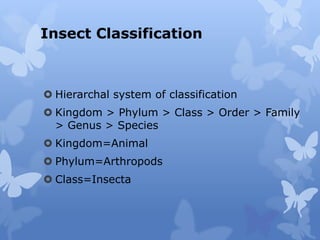
Insect Classification and Morphology Guide
- 1. Insect Classification Hierarchal system of classification Kingdom > Phylum > Class > Order > Family > Genus > Species Kingdom=Animal Phylum=Arthropods Class=Insecta
- 2. Arthropoda classes Crustacea Crayfish, sowbugs 2 body segments and 5 pairs of legs Arachnida Spiders, ticks, and mites 2 body segments and 4 pairs of legs Symphyla Symphylans 2 body segments and 12 pairs of legs .Insecta
- 3. Arthropods Segmented body Paired appendages Bilateral symmetry Chitinous exoskeleton Tubular alimentary system, with mouth & anus Open circulatory system Nervous system Respiration by gills, trachea, or spiracles Sexes are almost always separate
- 4. Insecta Bugs, beetles, and butterflies 3 body segments and 3 pairs of legs
- 5. Insect Orders About 28 different orders of insects Divided into these orders based on structure of wings and mouthparts and their type of metamorphosis Ametabolous: growth without change Paurometabolous: incomplete or gradual Hemimetabolous Holometabolous: complete metamorphosis
- 6. Holometabolous Ametabolous In ametabolous development there is simply a gradual increase in size of young until adult dimensions are attained.
- 7. Paurometabolous Hemimetabolous Paurometabolous means gradual metamorphosis that involves a nymphal stage. The embryo develops into a mature individual without involving a larval stage. The nymphs look very much like adults and it undergoes 13 moults to become an adult. (of an insect) having no pupal stage in the transition from larva to adult.
- 8. Collembola Springtails Ametabolous Orthoptera Grasshoppers, crickets Paurometabolous Isoptera Termites Paurometabolous Hemiptera True bugs paurometabolous
- 9. Homoptera Aphids, scales Paurometabolous Coleoptera Beetles, weevils Holometabolous Lepidoptera Butterflies & moths Holometabolous Hymenoptera Wasps , bees, ants holometabolous
- 10. Diptera Flies Holometabolous Siphonoptera Fleas Holometabolous Dermaptera Earwigs Paurometabolous Thysanura Silverfish ametabolous
- 11. Ephemeroptera Mayflies Hemimetabolous Odonata Dragonflies & damselflies Hemimetabolous Blattaria Cockroaches Paurometabolous Phasmida Walking sticks Paurometabolous
- 12. Mantodea Mantids Paurometabolous Phthiraptera Lice Paurometabolous Thysanoptera Thrips Hybrid between holo- and pauro-metabolous Neuroptera Lacewings, antlions Holometabolous
- 13. Morphology
- 14. Head: Antennae Filiform: threadlike, the segments are nearly uniform in size and usually cylindrical (ground beetle) Monofiliform: like a string of beads, segments are similar in size and more or less spherical in shape (some beetles) Clavate: segments increasing in diameter distally (ladybird beetles) Serrate: sawlike, segments more or less triangular (click beetle) Pectinate: comblike, most segments with long, slender, lateral processes (some beetles) Setaceous: bristlelike, segments becoming more slender distally (dragonfly, damselfly) Plumose: feathery, most segments with whorls of long hair (math moths; allows for more surface area to pick up pheromones; mosquitoes) Aristate: last segment usually enlarged and bearing a conspicuous dorsal bristal (blow flies; used as air speed indicators)
- 15. (Blow flies) (June Beetle) (Click beetle) (Cedar beetle) (Bark beetles) (Dragonfly) (Snipe fly) (Chalcid) (Mosquitoes) (Fire-colored Beetle) (Ladybird Beetle)
- 17. Chewing Rasping-sucking: Thrips Piercing-sucking: cicadas and mosquitoes Sponging: houseflies (lap up liquids) Siphoning: butterflies & moths Chewing-lapping: bees (have both mandibles and a proboscis) Vestigial: mayflies Head: Mouthparts
- 19. Thorax Prothorax, mesothorax, and metathorax Each segment bears a pair of legs Wings are attached to the mesothorax and metathorax, but never the prothorax Legs of insects vary greatly in size and form and are often used for classification purposes Walking, jumping, diggings, grasping, feeling, swimming, carrying loads, building nests, and cleaning Leg adaptations Grasshoppers: enlarged femur for jumping Beetle: enlongated tarsi for running
- 22. Wings Are the outgrowths of the body wall Venation can vary dramatically from species to species and is often used as a means for identification Most of insect orders end with “ptera”, which is greek for “with wings” Can be covered with fine hairs or scales (moths & butterflies) or bare (dragonflies)
- 23. Abdomen May have 11 or 12 segments, but often hard to distinguish from one another Some may have cerci at the tip of the abdomen (earwigs) Length can vary greatly from different insect species
- 24. Development Critical development occurs just after birth or egg hatch Reproduction Most need to mate in order for eggs to be fertilized Some are able to reproduce without sperm fertilization Some can reproduce either way
- 25. Insect Orders
- 41. Insect Injury Chewing insects Chew off portions of plant Piercing-sucking insects Pierce skin and suck up plant juices Internal feeders Gain entrance into plant and feed on the inside Subterranean insects Attack plant from below the soil surface Injury by laying eggs Nest materials Remove tissue to use in nests Vectors of plant diseases
- 46. Beneficial insects Pollinators Aid in the production of fruits, seeds, vegetables, and flowers Weed feeders Improve physical condition of soil and promote fertility by burrowing Millipedes, centipedes Scavengers Devouring bodies of dead animals and plants Bury carcasses and dung
- 47. Beneficial insects Predators Catch and feed on other creatures (prey) Ground beetles Lace wings and lady bugs Parasites Live on or in the bodies of living organisms (hosts) Host are usually larger and stronger than the parasites and are not killed promptly Parasitic wasps of aphids and hornworms